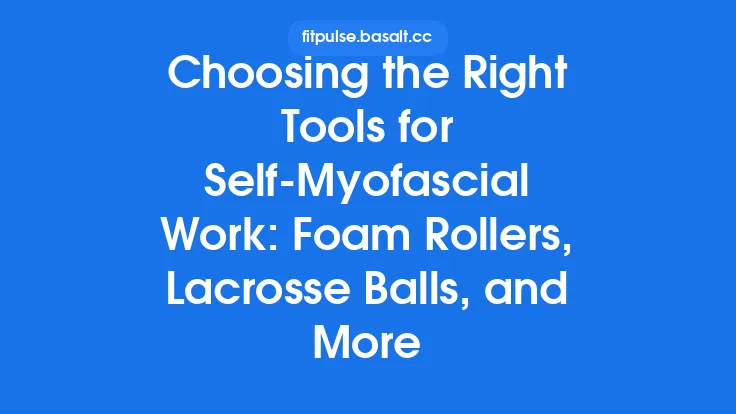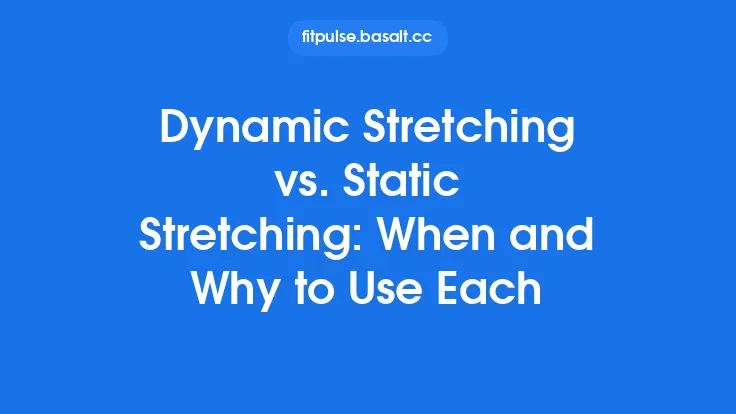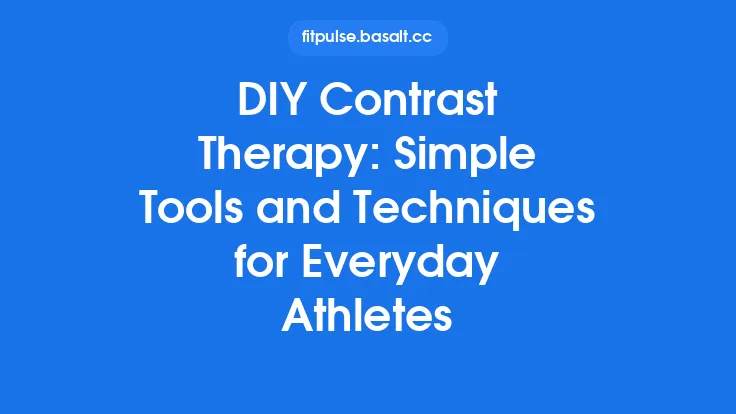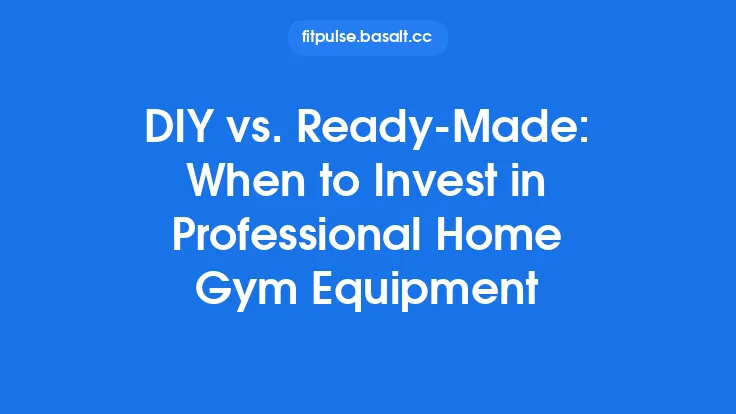When it comes to keeping muscles supple, joints mobile, and everyday aches at bay, a well‑chosen self‑massage tool can be a game‑changer. While commercial kits can be pricey, many athletes, coaches, and everyday movers discover that a few simple, homemade implements—balls, sticks, and rollers—provide just the right amount of pressure, leverage, and surface area to address tight spots, improve circulation, and speed up recovery. The key isn’t just having a tool; it’s knowing when each type shines, how to tailor it to your body, and how to build or maintain it so it lasts.
Understanding the Three Core Tool Families
| Tool | Typical Shape & Size | Primary Mechanical Action | Ideal Use Cases |
|---|---|---|---|
| Ball | Spherical, 2–6 in (5–15 cm) diameter | Point‑load pressure; can be static or rolled | Small, deep trigger points (e.g., glutes, plantar fascia, forearm flexors) |
| Stick | Cylindrical rod, 12–36 in (30–90 cm) length, 0.5–1 in (1.3–2.5 cm) diameter, often with textured ends | Lever‑based rolling; allows user‑controlled pressure via body weight | Long muscle groups (hamstrings, calves, IT band) and areas needing a “self‑massage lever” |
| Roller | Cylindrical tube, 12–36 in (30–90 cm) length, 3–6 in (7.5–15 cm) diameter | Broad‑surface rolling; distributes pressure over larger area | General myofascial release, warm‑up, post‑workout flushing of metabolites |
Each family offers a distinct blend of contact area, pressure concentration, and mechanical advantage. By matching these attributes to the size and depth of the tissue you want to treat, you can achieve more precise relief without over‑relying on a single tool.
Balls: Targeted Pressure for Small Areas
Why Balls Work
A ball’s small contact patch concentrates force, allowing you to isolate a single knot or trigger point. Because the pressure is highly localized, you can apply enough load to break up adhesions without overwhelming surrounding tissue.
When to Reach for a Ball
| Situation | Recommended Ball Type | How to Use |
|---|---|---|
| Plantar fasciitis | Tennis ball (≈2.5 in) or lacrosse ball (≈2 in) | Sit, place the ball under the arch, and gently roll forward and back, adjusting pressure with body weight. |
| Gluteal trigger points | Lacrosse or rubber massage ball (≈2 in) | Lie on your side, position the ball under the glute, and slowly shift weight to press into the knot. |
| Forearm flexor tightness | Small rubber or silicone ball (≈2 in) | Rest forearm on a table, roll the ball along the muscle belly, focusing on tender spots. |
| Neck and upper traps | Soft foam or silicone ball (≈3 in) | Sit upright, let the ball rest against the side of the neck, and gently tilt head to apply pressure. |
DIY Ball Construction
- Materials – Solid rubber (e.g., a cut‑up garden hose), dense foam, or a high‑density silicone mold.
- Mold – Use a spherical mold (a clean, smooth bowl or a 3‑D‑printed sphere) and pour the material.
- Finishing – Sand the surface lightly to remove rough edges; coat with a thin layer of silicone spray for slip resistance.
Tip: For a “dual‑density” ball, embed a harder core (e.g., a small rubber pellet) within a softer outer layer to mimic commercial massage balls that offer a firm center with a cushioned shell.
Sticks: Leveraging Mechanical Advantage
The Mechanics Behind Sticks
A stick functions like a lever: the farther you position the contact point from your body, the less effort you need to generate pressure. This makes sticks ideal for long muscle groups where you want to control depth without straining your hands or wrists.
Ideal Scenarios for Stick Use
| Muscle Group | Stick Length & Diameter | Technique |
|---|---|---|
| Hamstrings | 24–30 in, 0.75 in diameter, smooth or ridged | Sit on the floor, place the stick under the hamstring, and roll forward using your hands for guidance. |
| Calves | 18–24 in, 0.5–0.75 in diameter, textured ends | Stand, place the stick under the calf, and shift weight from heel to toe, allowing the stick to glide. |
| IT Band | 30–36 in, 0.75–1 in diameter, ridged surface | Lie on your side, position the stick under the outer thigh, and use your body weight to roll from hip to knee. |
| Forearm extensors | 12–18 in, 0.5 in diameter, smooth | Sit, rest forearm on the stick, and roll back and forth, adjusting pressure with elbow flexion. |
DIY Stick Fabrication
- Core – Use a solid PVC pipe (½–1 in diameter) as the backbone.
- Surface Texture – Wrap the pipe with a strip of sandpaper, rubberized grip tape, or a patterned silicone sleeve to add friction.
- Ends – Cap both ends with rubber plugs to prevent slipping and protect floors.
- Optional Handles – Add a small foam grip near the middle for better control during deep work.
Safety Note: Ensure the stick is free of sharp edges and that any added texture is securely attached to avoid slippage.
Rollers: Broad‑Surface Myofascial Work
What Makes Rollers Unique
Rollers spread pressure across a larger area, making them perfect for general myofascial release and for warming up larger muscle groups before activity. Because the contact area is wide, they are less likely to cause bruising, which is beneficial for beginners or those with sensitive tissue.
Situations Where Rollers Excel
| Use Case | Roller Size & Density | How to Apply |
|---|---|---|
| Full‑body warm‑up | 36 in length, 4 in diameter, medium‑density foam | Lie on the roller and slowly glide from head to toe, pausing on tight spots. |
| Post‑run calf flush | 24 in length, 3 in diameter, softer foam | Place the roller under the calves, roll from ankle to knee, using body weight to control pressure. |
| Upper back release | 24 in length, 4 in diameter, firmer foam | Position the roller horizontally across the upper back, support the head with hands, and roll gently. |
| Hip flexor stretch | 12–18 in length, 3 in diameter, medium‑soft foam | Lie face‑down, place the roller under the hip flexor, and gently rock forward and back. |
DIY Roller Construction
- Core Material – Use a PVC pipe (4–6 in diameter) as the structural spine.
- Foam Layer – Wrap the pipe with high‑density EVA foam sheets, securing them with industrial adhesive. For a softer feel, add a second outer layer of low‑density foam.
- Cover – Slip a washable, breathable fabric (e.g., nylon or polyester) over the foam and secure with a zip tie or Velcro strap. This protects the foam and makes cleaning easy.
- Optional Texturing – Add a patterned rubber mat (e.g., a yoga mat cut to size) between foam layers for added grip.
Tip: For a “dual‑density” roller, use a firmer foam core (e.g., 1‑inch thick) surrounded by a softer outer layer (½‑inch) to mimic commercial rollers that provide both deep and superficial pressure.
Choosing the Right Tool for Your Needs
- Identify the Target Area – Small, deep knots → ball; long, linear muscles → stick; broad, superficial work → roller.
- Assess Pain Tolerance – Sensitive individuals may start with a softer ball or a larger‑diameter roller before progressing to firmer tools.
- Consider Mobility Constraints – If you have limited range of motion, a shorter stick or a smaller ball can be easier to maneuver.
- Factor in Frequency of Use – Tools that will see daily use should be built from durable materials (e.g., PVC core, high‑density foam) and have a protective outer cover.
- Budget & Space – DIY balls and sticks require minimal material and storage space, while rollers need a bit more room but can double as a yoga prop.
Safety and Maintenance
- Inspect Regularly – Look for cracks in foam, loose ends on sticks, or surface wear on balls. Replace any compromised component to avoid injury.
- Clean After Each Session – Wipe foam surfaces with a mild disinfectant (e.g., diluted hydrogen peroxide) and let dry. For rubber or silicone balls, a quick rinse with warm water works well.
- Avoid Over‑Pressurizing – Especially with balls, start with light pressure and increase gradually; excessive force can cause bruising or exacerbate inflammation.
- Protect Sensitive Areas – Use a thin towel or cloth between the tool and skin when working over bony prominences (e.g., knees, elbows).
- Store Properly – Keep tools in a cool, dry place away from direct sunlight to prevent foam degradation. A simple canvas bag or a dedicated shelf works fine.
Integrating DIY Tools into Your Recovery Routine
- Pre‑Workout Activation – Use a roller for 2–3 minutes on major muscle groups to increase blood flow and improve tissue pliability.
- Post‑Workout Flush – After a heavy lifting session, spend 1–2 minutes per muscle group with a stick to help disperse metabolic waste.
- Targeted Pain Relief – On days when a specific knot flares up, allocate 30–60 seconds of focused ball work, repeating 2–3 times per day.
- Rest‑Day Maintenance – A gentle, full‑body roll on a softer roller can aid circulation without adding stress.
- Progressive Loading – As tolerance improves, increase the duration or pressure gradually—e.g., move from a soft foam ball to a denser rubber ball, or from a 3‑inch roller to a 4‑inch one.
Common Pitfalls to Avoid When Using DIY Tools
| Pitfall | Why It Happens | How to Prevent |
|---|---|---|
| Using a ball that’s too hard for the area | Desire for deeper pressure without considering tissue sensitivity. | Start with a softer ball; test pressure on a non‑painful area first. |
| Rolling too quickly | Trying to “speed up” the session. | Move slowly (1–2 inches per second) to allow tissue to respond. |
| Neglecting body alignment | Focusing only on the tool, not on posture. | Keep spine neutral; engage core to support weight distribution. |
| Applying excessive force on joints | Misidentifying a joint as a muscle knot. | Avoid direct pressure on bones; use a towel or shift to a softer surface. |
| Skipping tool maintenance | Assuming DIY tools are “indestructible.” | Schedule weekly visual checks and cleaning. |
| Relying on a single tool for all issues | Over‑generalizing tool utility. | Match tool to specific muscle group and depth, as outlined above. |
Final Thoughts
DIY self‑massage tools empower you to take control of your recovery without breaking the bank. By understanding the distinct mechanical advantages of balls, sticks, and rollers, you can select—or craft—the perfect implement for any muscle group, pain level, or training phase. Remember that the most effective routine blends targeted pressure (balls), lever‑based rolling (sticks), and broad‑surface release (rollers) in a balanced, safe manner. With a little creativity, a few inexpensive materials, and a commitment to regular maintenance, you’ll have a versatile toolbox that supports mobility, reduces soreness, and keeps you moving forward—day after day.





